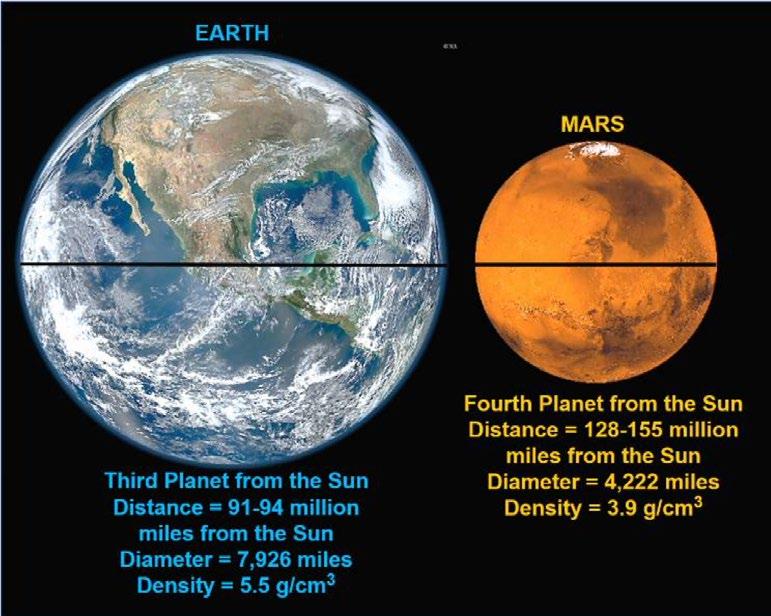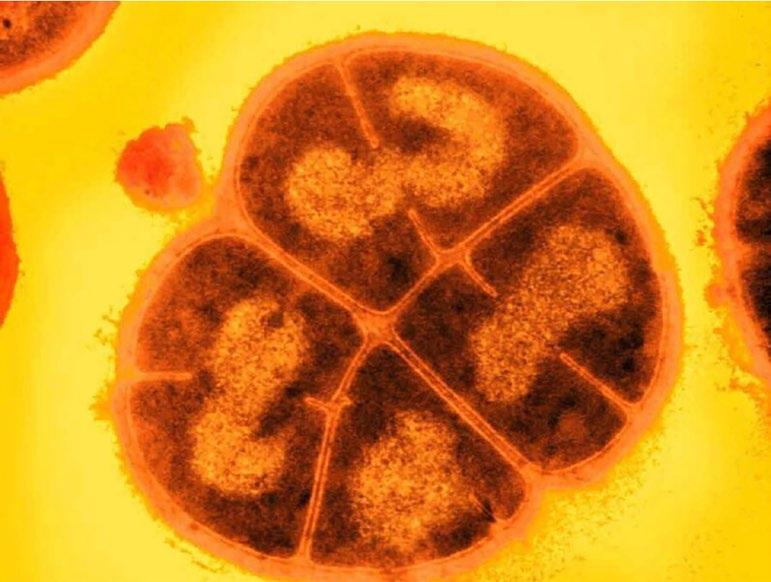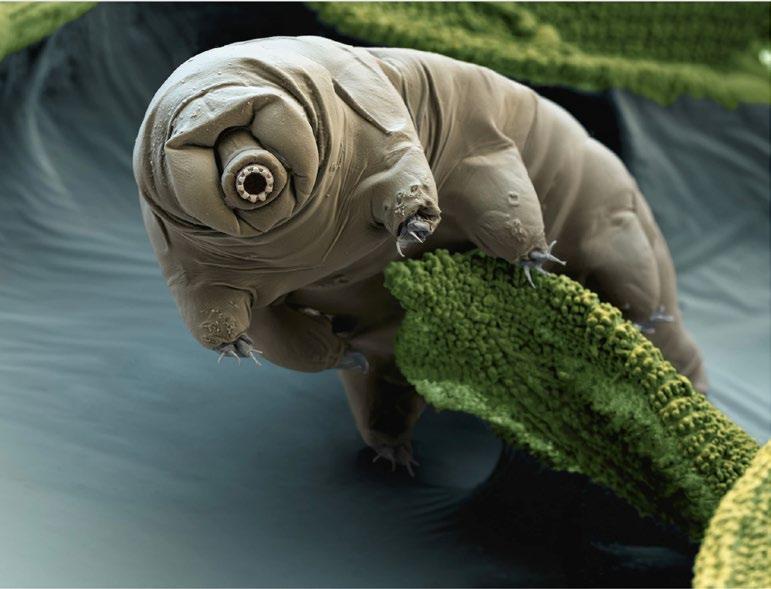
6 minute read
Searching for Extraterrestrial Life
Is there more life out there?
by PB Tanawattanakul
Astrobiology is the study and search for extraterrestrial life. Nasa’s Perseverance rover has found organic molecules on the dry river delta on Mars. Many molecules containing carbon, which are the fundamental building blocks of life, have also been discovered. When looking for extraterrestrial life, scientists look for biosignatures that could indicate evidence of life or former life on that planet. A biosignature could be any element, molecule, or substance that suggests the presence of organisms and provide evidence of their metabolic activities.
An example of a biosignature is methane; it has been proposed as an exoplanet biosignature. Methane can be produced by many metabolic mechanisms, such as outgassing (the release of gas) and serpentinisation (seawater releasing hydrogen that can reduce carbon dioxide to methane). Methane is an unstable gas existing in the atmosphere, therefore, if methane is found on a planet, it must be constantly replaced.
Exoplanets
Exoplanets are planets that are outside of our solar system, and orbit around other stars. They can also be free-floating and untethered to a star, and these exoplanets are called rogue planets (NASA, 2021).
To look for life outside of planet Earth, astrobiologists search for other rocky planets outside of the solar system to determine whether that planet could support life. There are many methods used by scientists to discover exoplanets. One of the many methods is direct imaging, but only a small number of exoplanets have been discovered this way, as it is difficult to see an exoplanet through a telescope. A more favourable method where most exoplanets are found is the transit method, measuring the dimming of a star while a planet passes it, and using the Doppler shift to see if there is a planet pulling on a star’s light.
The Goldilocks zone
In celestial space, very few planets ever come close to possessing Earth’s habitable conditions. The Goldilocks zone is known as a habitable zone, where temperatures are not too high or low, and just enough to sustain life (NASA, 2022). If the Earth was much closer to the Sun, like Mercury, our water on would boil and evaporate, creating a steam atmosphere. On the other hand, if Earth was much further away from the sun, like Pluto, the water would freeze. The Goldilocks zone is the range of distance close enough to the sun for water to remain in a liquid state, but not so far as to where all the water would become frozen.
Scientists are looking for planets similar to Earth, and although many show potential signs of habitability, Earth is the only one that we know of to have life on it. Some examples of planets in the Goldilocks zone include Kepler-186f and Mars. Although other planets have been found in this habitable zone, they are all larger than Earth, which makes the study of their compositions more difficult.
Kepler-186f is an exoplanet which has similar properties to Earth, such as a similar size, a rocky composition and liquid water on its surface (Culler, J, 2014). However, despite all of its ideal conditions, Kepler-186f only receives a third of the energy from its star that Earth receives from the Sun. Kepler186f is therefore placed on the outer edge of the habitable zone. It is also 500 light years away from Earth.
Another potential candidate located in the Goldilocks zone is Mars. Both Mars and Earth have valleys and mountains, weather and seasons, and one Martian day is only less than an hour longer than Earth’s (Williams, M., 2015). This makes Mars seem like an ideal place for humans to inhabit. Nevertheless, although Mars has been considered to be a ‘second Earth’ within our solar system, there are still many differences between the two. As seen in Fig 2, the image shows Earth in comparison to Mars; Earth is larger and is at a shorter distance from the Sun. Furthermore, while Earth is covered with liquid water, any trace of water on Mars is frozen under the north and south polar ice caps. The air on Mars is also thinner than Earth’s air. The air on Earth is made up of up to 21% oxygen, which allows humans to live and breathe comfortably on Earth. In contrast, Mars’ air is made up of only 0.13% oxygen, and most of the air is composed of carbon dioxide, which makes it difficult for humans to survive on Mars’ land without any extra supply of oxygen. Mars is also an exceedingly hostile place; with a frozen and dry surface, the cosmic radiation and bombarding protons that would instantly kill any human setting foot upon it.

Despite the fact that Mars would not be able to provide an optimal environment for humans to live in, other organisms that are susceptible to living in more extreme conditions could survive on Mars. Most life on planet Earth such as humans, animals, and plants, require very specific conditions to survive. However, extremophiles, a group of microorganisms that are recognised for their ability to live in ‘extreme’ conditions, are well adapted to living in severe environments and therefore would be fit for living in such conditions of Mars.
Life in extreme environmentsextremophiles
capable of living in extreme conditions, and they thrive in the extreme environments. A thermophile, as its name suggests, would thrive in hot temperatures without their enzyme activity decreasing or their proteins becoming denatured. Psychrophiles, on the other hand, survive in extremely cold temperatures without becoming frozen or letting water expand inside of them and rupturing their bacterial cell walls. Taking into account the environment on Mars, the microorganism that would be able to survive there would need to be a psychrophile to live in the cold temperatures and be radiation-resistant extremophiles to withstand the high doses or radiation on the planet.

Conan the bacterium
Extremophiles are able to live in harsh environments of extreme temperature, pH, salinity, pressure and radiation. These microorganisms have been found deep inside the Earth’s crust, withstanding incredibly high temperatures, and they can also be found living deep inside the ocean at high pressures. Extremophiles are suggestive of the possibility of finding extraterrestrial life, and also may provide an insight into the origins of life on Earth. Since habitable conditions that could support life outside of Earth are so rare, the adaptability and simplistic needs of extremophiles seems more achievable for existence of life outside of Earth.

There are many types of extremophiles - ‘phile’ means to love and be attracted to something. These microorganisms are
In Fig 4 is Deinococcus radiodurans, a microbe known as Conan the Bacterium which was found to have qualities that would allow it to survive on Mars (Magazine, S., 2022). This microbe is one of the toughest microbes on earth, as it is capable of remaining alive even in radiation that would kill other organisms. They are considered as a polyextremophile because they are able to survive many types of extreme environments. They fulfil the requirements of being able to survive in both hot and cold temperatures, and they are also able to survive under high doses of radiation. Scientists tried exposing Conan the Bacterium to ultraviolet light and radiations such as protons and gamma rays to simulate the space-like radiation found on Mars. The bacterium was able to endure extremely high doses of radiation up to more than 100,000 grays. In comparison, humans would suffer fatal health problems after exposure of 0.3 grays of radiation.
The discovery of Conan the bacterium’s ability to withstand such radiation shows it is able to survive the environment on Mars. This suggests that the bacterium along with similar species to it could be lying dormant underneath Mars’ ground for millions of years. However, even if samples of organisms from Mars could be retrieved back to Earth, scientists need to be careful to not contaminate Earth with microbes from Mars. In addition, if humans were ever to visit Mars, they must also be careful to not bring microbes from Earth to Mars, as it could disrupt the native microbial life there.
Discussion questions
1. Should we discover a planet enriched with useful resources, are we ethically permitted to take them for use on Earth?
2. Would colonising Mars be worth the risk of potentially harming life forms that are indigenous to the planet?
References
Culler, J. (2014). Kepler Finds 1st Earth-Size Planet in ‘Habitable Zone’ of Another Star. [online] NASA. Available at: https://www.nasa.gov/ames/ kepler/nasas-kepler-discovers-first-earth-size-planet-in-the-habitable-zoneof-another-star. [Accessed on 01/05/23]
Exoplanet Exploration: Planets Beyond our Solar System. (n.d.). Goldilocks Zone. [online] Available at: https://exoplanets.nasa.gov/resources/323/ goldilocks-zone/#:~:text=The%20%27Goldilocks%20Zone%2C%27%20or.
[Accessed on 01/05/23]
Magazine, S. and Kuta, S. (n.d.). ‘Conan the Bacterium’ Has What It Takes to Survive on Mars. [online] Smithsonian Magazine. Available at: https://www. smithsonianmag.com/smart-news/conan-the-bacterium-has-what-it-takesto-survive-on-mars-180981019/. [Accessed on 01/05/23]
Interested in learning more?

Here’s a YouTube video you may enjoy:
NASA (2021). Overview | What is an Exoplanet? [online] Exoplanet Exploration: Planets Beyond our Solar System. Available at: https:// exoplanets.nasa.gov/what-is-an-exoplanet/overview/. [Accessed on 01/05/23]
Williams, M. (2015). Mars compared to Earth. [online] phys.org. Available at: https://phys.org/news/2015-12-mars-earth.html. [Accessed on 01/05/23]










